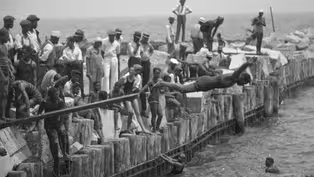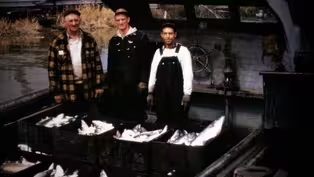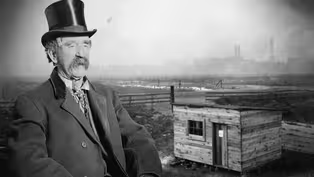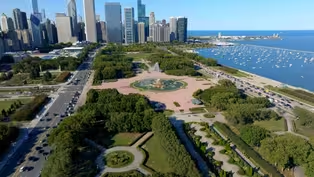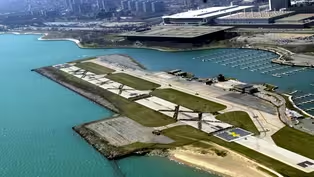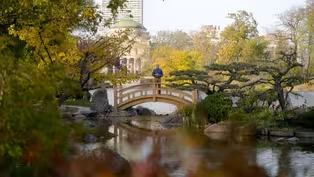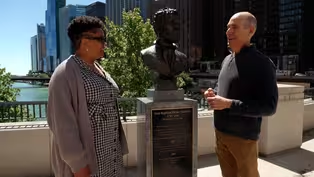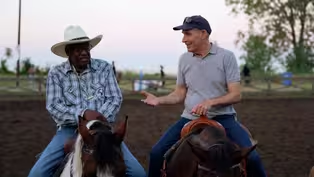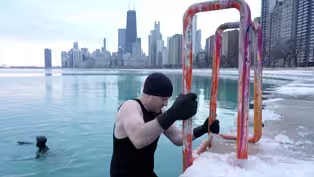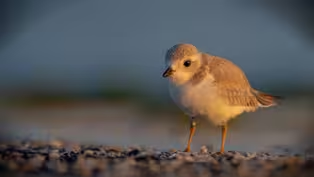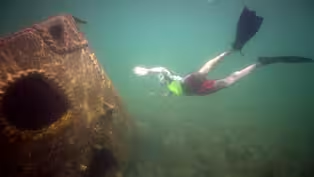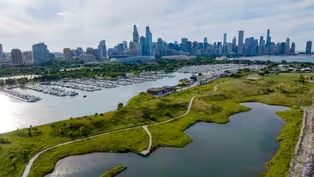
Fishing on Lake Michigan
Clip: Special | 5m 52sVideo has Closed Captions
Geoffrey Baer embarks on a fishing trip on Lake Michigan.
While out on a boat on Lake Michigan, Geoffrey Baer catches a lake trout, a species that was once a dominant predator fish in the Great Lakes. Commercial overfishing and invasive species decimated the population. But fishery management has led to a recovery of the species, as well as the introduction – and success – of non-native salmon.
Problems playing video? | Closed Captioning Feedback
Problems playing video? | Closed Captioning Feedback
Chicago Tours with Geoffrey Baer is a local public television program presented by WTTW

Fishing on Lake Michigan
Clip: Special | 5m 52sVideo has Closed Captions
While out on a boat on Lake Michigan, Geoffrey Baer catches a lake trout, a species that was once a dominant predator fish in the Great Lakes. Commercial overfishing and invasive species decimated the population. But fishery management has led to a recovery of the species, as well as the introduction – and success – of non-native salmon.
Problems playing video? | Closed Captioning Feedback
How to Watch Chicago Tours with Geoffrey Baer
Chicago Tours with Geoffrey Baer is available to stream on pbs.org and the free PBS App, available on iPhone, Apple TV, Android TV, Android smartphones, Amazon Fire TV, Amazon Fire Tablet, Roku, Samsung Smart TV, and Vizio.
In all my years of living in Chicago, I've never gone fishing.
I figured it was time.
14 miles offshore, the lake is a whole different kettle of fish.
- This lake was almost netted into extinction in the 1800s.
And now there's so much life out here.
- [Geoffrey] The good ship Angler is under the command of Captain Gintas and first mate Johnny Mcintyre.
- I mean, the fact that a lake can support five different species of Pacific Ocean salmon really just speaks for how healthy and amazing this fishery is.
All within view of the city of Chicago.
- Yeah.
How about that?
The fishery might be thriving, but those salmon and other species aren't native to Lake Michigan.
More on that later.
First, I need to get up to speed.
So this is your bait?
- Correct?
- You're not using like a worm.
- We are not.
- [Geoffrey] My mind was reeling from all the jargon.
- I'm setting back our lead line rods here.
Now we're into backing.
And this is called braided line.
You can feel it, it's very thin.
Sharp three-pronged hook.
It's called the treble hook.
And now what I do is put on my spreader board.
- [Geoffrey] Your spreader board.
There's too much jargon in this.
- I turn my clicker on, which is making that sound, right?
And that's polishing my drag as I set this line up.
So if you come over here, this line's going to get sent the furthest back of any line we fish today.
- Four downriggers, four downriggers, two dipsies, two lead cores- - [Johnny] And two copper lines.
- And two copper lines.
There'll be a test afterwards.
I had a sinking feeling I'd come back empty-handed, but Captain Gintas said not to worry.
- We've never come back without a fish.
- Never come back without a fish.
- Never come back without a fish.
- Well, there's always a first time.
For about 20 minutes, nothing was biting, and then, seemingly out of nowhere- - Fish two, two, two!
- Whoa, what do I do?
- [Johnny] Alright, tip up, Geoff.
Tip up.
Fight him right here.
- Stop right here.
- The bottom here.
- [Johnny] No, no, no.
Keep that rod right here.
Put this right here.
- Right here.
- [Johnny] There you go.
Reel, reel, reel.
- Whoa, I can feel that.
Geez.
I think I got a big one.
- You see him on the surface of water there?
He's running at us real quick.
Real quick.
Good.
Good, good, good.
- You see him?
I don't see him.
Oh my God.
I can feel him pulling.
- Stop reeling.
Tip up, walk backwards.
Tip up, walk backwards.
There we go.
Netted!
- [Geoffrey] Oh man.
- So this is a lake trout.
This is your first ever fish, correct?
- Yeah.
It is.
- This is a pretty damn good first fish.
- Okay.
(chuckles) My smile as i posed for those trophy photos covered up a surprising feeling of guilt that washed over me.
I mean, I was like, hey, this poor thing is fighting for its life and I'm going to kill it.
- Yeah, some people have a little bit of that sort of sentiment when they kill their first fish, but this is the most sustainable way for anybody to eat fish is to catch it yourself.
The biggest threat to any fish population is commercial, especially netting and long lining, stuff like that.
Right from the lake to the cooler to your table.
Sustainable way.
No waste, no bycatch, nothing like that.
Just clean, simple.
Done.
- Sustainable, yes.
But there are enough trace contaminants in the water that authorities recommend limits on the amount of fish we eat from Lake Michigan.
This lake might be freshwater, but Captain Gintas is an old salt with more than 30 years under his belt.
So you've seen a lot of changes in the lake in your career.
- I've seen tremendous changes.
- [Geoffrey] Gintas has seen the arrival of several invasive species.
But he's also witnessed how the lake adapts, for example, to zebra mussels that arrived in the ballast water from foreign ships and depleted the food supply for native fish.
Or the round goby, a native to the Caspian sea that gobbled up the mussels, but created their own problems.
- So then you started reading about, the goby is going to destroy this lake.
They's going to eat all the little fish and the lake is doomed.
So what's happened with that invasive species?
Now everything is learned to eat this goby.
The white fish that learned to eat it, king salmon, 48 pound king salmon, a lake record.
- [Geoffrey] Now is that a fish story?
- I have a picture.
(laughs) - Speaking of salmon, how on earth did a Pacific species end up in Lake Michigan?
Well, you can thank a scientist named Howard Tanner.
In 1966, he introduced these apex predators to restore balance to a lake that was dangerously out of whack, so bad you could smell it.
The culprit was an earlier invasive species called the alewife.
- [Gintas] And this lake became saturated with alewives.
And I remember as a kid going to the beach- - [Geoffrey] Oh, me too.
- [Gintas] And the alewives dead.
Alewives are up through your knees and they got to plow 'em and bury 'em.
- [Geoffrey] Smell terrible, dead alewives.
- They're all dead, and you couldn't walk barefoot because they would hurt your feet.
So in the '60s, the DNR decided it might be a good idea to start stocking pacific salmon, steelhead brown trout- - [Geoffrey] To eat the alewives.
- To eat the alewives to balance out that predator/prey relationship.
- [Geoffrey] Along Chicago's lakefront, nature is manmade from the fishery below the surface to the view on the horizon.
Does it ever get- - It never gets old.
But those are my mountains.
- Yeah.
- [Gintas] Those are my mountains.
That's the way I look at it.
But this is my favorite view of the city.
14 miles off shore.
31st Street Beach and the Red Summer of 1919
Video has Closed Captions
Clip: Special | 4m 45s | Racial violence in Chicago first exploded at a lakefront beach during the Red Summer. (4m 45s)
Calumet Fisheries and the Legacy of Commercial Fishing
Video has Closed Captions
Clip: Special | 3m 51s | Calumet Fisheries is a rare survivor of Chicago’s commercial fishing days. (3m 51s)
The Con Man Who Staked a Claim on Streeterville
Video has Closed Captions
Clip: Special | 2m 3s | Chicago’s Streeterville neighborhood was once a seedy vice district. (2m 3s)
Grant Park: Forever Open, Clear, and Free
Video has Closed Captions
Clip: Special | 6m 42s | A. Montgomery Ward launched a legal battle to preserve the lakefront for the people. (6m 42s)
How Meigs Field Became Northerly Island (Again)
Video has Closed Captions
Clip: Special | 4m 34s | A former lakefront airport has become a green space once envisioned by Daniel Burnham. (4m 34s)
Jackson Park and The White City
Video has Closed Captions
Clip: Special | 2m 1s | Jackson Park was the site of the World’s Columbian Exposition. (2m 1s)
Jean Baptiste Point DuSable's Lakefront Homestead
Video has Closed Captions
Clip: Special | 3m 20s | Jean Baptiste Point DuSable built a homestead at the convergence of the river and lake. (3m 20s)
Video has Closed Captions
Clip: Special | 3m 44s | A horseback riding club teaches equestrian skills to a new generation. (3m 44s)
Meet Chicago's Winter Swimmers
Video has Closed Captions
Clip: Special | 4m 49s | Meet the swimmers who swim in Lake Michigan year-round – even in winter weather. (4m 49s)
The Montrose Beach Piping Plovers
Video has Closed Captions
Clip: Special | 4m 35s | Montrose Beach became a nesting site for piping plovers in 2019. (4m 35s)
The NASCAR Chicago Street Race
Video has Closed Captions
Clip: Special | 2m 56s | Geoffrey Baer visits the NASCAR Chicago Street Race. (2m 56s)
Video has Closed Captions
Clip: Special | 4m 44s | A shipwreck sits just 600 feet off Chicago’s lakefront on an ancient reef. (4m 44s)
The Surprising History of Promontory Point
Video has Closed Captions
Clip: Special | 1m 32s | Promontory Point is yet another example of Daniel Burnham’s Plan of Chicago. (1m 32s)
Touring Chicago's Lakefront Trailer
Video has Closed Captions
Preview: Special | 1m 1s | Preview Touring Chicago's Lakefront, combining history and shining light on contemporary challenges. (1m 1s)
Providing Support for PBS.org
Learn Moreabout PBS online sponsorshipSupport for PBS provided by:
Chicago Tours with Geoffrey Baer is a local public television program presented by WTTW
